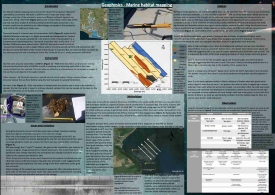

Geophysics Survey
Introduction
For the geophysics component of the field trip we mapped out an area of the sea bed of our choice within Plymouth sound. Our chosen area was Cawsand Bay to the West of Plymouth Sound as it was yet to be studied and promised differing sediment types over the course of our transects according to charts of the area (gpsnauticalcharts).
While our transects and habitat map showed results of mostly coarse, hard sediments, previous studies of the area showing that Cawsand bay has mostly fine sediments (D.M.Parry, et al. 1999) as shown in Figure 1 especially when compared to other locations in Plymouth Sound.
Aims
- Using a side scan sonar to identify geomorphic features as well as sediments on the sea bed of Cawsand bay
- From the side scan trace, identify different habitats and view them using a video camera to provide a less intrusive viewing method.
- Identify species and sediment present in the various habitats using van veer grabs to collect physical samples that can be viewed on the back deck of the vessel.

To learn more click on the poster below

References
- Plymouth Sound Chart, Accessed 10/07/2019 http://fishing-app.gpsnauticalcharts.com/i-boating-fishing-web-app/fishing-marine-charts-navigation.html?title=Plymouth+Sound+and+Approaches+boating+app#14/50.3278/-4.1854
- Parry, D. M., Kendall, M. A., Rowden, A. A. and Widdicombe, S. (1999) “Species body size distribution patterns of marine benthic macrofauna assemblages from contrasting sediment types,” Journal of the Marine Biological Association of the United Kingdom. Cambridge University Press, 79(5), pp. 793–801. doi: 10.1017/S0025315499000971.

Metadata
Date - 05/07/2019
Time - 12:30-16:30 (UTC+1)
Low Tide - 14:44 (UTC+1) (0.79m)
High Tide - 08:35 (UTC+1) (5.31m)
Wind Speed, Direction - 11mph, SSW
Air Temperature - 22ᵒC
Pressure - 764.31mmHg
Cloud coverage - 0/8
| Nutrients |
| Water Column |
| Plankton Distributions |
| Nutrients |
| Water Column |
| Plankton Distributions |
| DAPI |
| References |
| Meet the Team |
| Laboratory protocols |